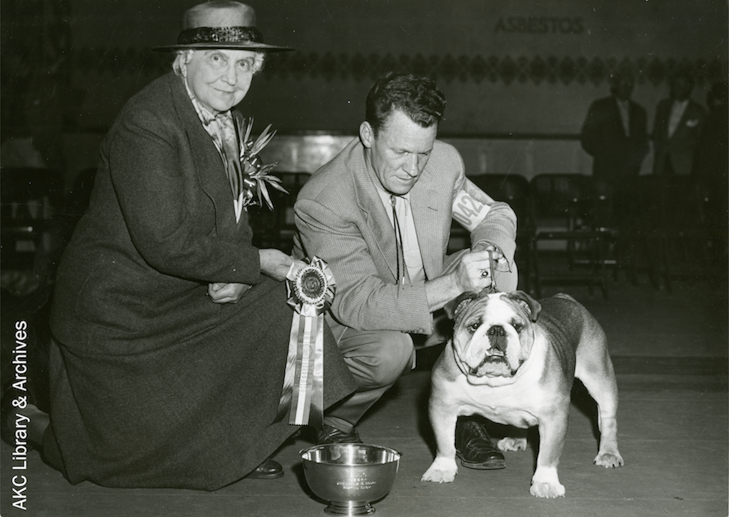
AKC is a participant in affiliate advertising programs designed to provide a means for sites to earn advertising fees by advertising and linking to akc.org. If you purchase a product through this article, we may receive a portion of the sale.
One of the most distinctive-looking dog breeds, the Bulldog is also famous for its stubborn mannerisms and wrinkly appearance. But representatives of this historic breed are more than just good-looking dogs. The ups and downs of their unique history attest to their enduring popularity.
The Bulldog’s Beginnings
The Bulldog reportedly received its bullish moniker from the breed’s use in the medieval sport of bullbaiting. A bull (or bear, lending the custom the name “bearbaiting”) would be tied or chained to a stake and would have to fight a dog: presumably a Bulldog.
In the 1938 Blue Book of Bulldogs, William Lawlor wrote that the Bulldog can be traced to 1210, the year of the first official bullbaiting in England. He added that the Bulldog “is generally believed to have come down from the same common stock” developed for that sport. That meant these dogs had to be tough enough to face down a mighty bovine.
However, as the centuries progressed, the sport came under fire. Bullbaiting was banned in 1835. Annette Nobles, president of Division VIII of the Bulldog Club of America (BCA), which covers Tennessee, Mississippi, Alabama, Georgia, and Florida, says, “The end of the blood sport of bullbaiting left the Bulldog breed with no job or purpose.”
Nobles notes that at that time, the breed was “considered to be savage.” Its owners also came from the lower classes. However, she adds, “The introduction of formal dog shows in 1859 saved the breed from extinction.” The breed as we know it today evolved from the last survivors prior to that time.
Around 1860, the Bulldog began to be bred for exhibition purposes, and breeders began to breed for different physical and temperamental characteristics. Nobles notes, “To prevent cross-breeding and to keep the breed as it stood, fanciers formed the first Bulldog Club in 1864, its motto being ‘hold fast.’ The Bulldog Club’s objective was to preserve and improve the English Bulldog. This club lasted approximately three years and is credited with the first attempt at a standard.
She adds that “1875 saw the incorporation of the Bulldog Club in England, which is a thriving club to this day. The goal of this club was to protect one type of Bulldog and the club created the first ‘standard’ for the breed.”
In an April 1991 AKC Gazette article, Ann Hier notes that breeders “turned the qualities that had made the animals such a superior gladiator into qualities of character.” In part, they did so by choosing animals with gentle temperaments for breeding stock. The breed’s adjusted temperament and physical makeup were “pretty much established by the advent of dog shows, between 1859 and 1885,” Hier adds.

By 1877, Bulldogs competed competing in the first Westminster Kennel Club Show, and Robinson Crusoe became the first champion of the breed in 1888. The breed fully received recognition in 1886, a hallmark of the devotion and ethical preservation of the Bulldog.
In 1890, breed enthusiasts organized the first meeting of the Bulldog Club of America in the United States. Nobles says, “The Bulldog Club of America adopted standards for the breed in 1894, closely following the same standards that were developed originally by the English club. There was very little difference in the standards.”
One of the most important contributions to the modern breed was Kippax Fearnought. Imported to America by Dr. John Saylor, the British-bred Bulldog was named Westminster Best in Show in 1955. He then became a foundation sire for the breed in America, siring seven champions. The breed has gone from strength to strength in recent decades.
Developing into a Modern Classic
Cody Sickle of Cherokee Legend Bulldogs shared, “Through the early 1900s, the breed’s personality, the disposition, the ability to live with everybody was given such importance that it’s become the great personality that it is today. I got my first Bulldog more than 60 years ago; the personalities were spectacular back then, too. So the people that made the transformation of this breed from a fighting dog into a family dog did a great job and did it long before I ever got involved with the breed.”
Sickle has been showing Bulldogs since 1963 and breeding them since 1966. Named American Kennel Club’s 2004 Non-Sporting Breeder of the Year, Sickle maintains an avid love for the breed. He recalled, “The first thing that grabbed me was the look. It’s certainly distinctive. Nothing else looks like a Bulldog. After getting my first puppy, it became very apparent to me immediately what a great pet this is. The disposition of this breed is second to none. It’s a great family dog, frankly.”

Sickle says, “One of the things that I will say to my dying day—that the Bulldog breeders from my time in my beginnings right through now—the top breeders in this country have been superb. Because one of the things that I will say without hesitation, the quality of this breed has improved dramatically in my lifetime.”
He adds, “And the health of this breed has improved exponentially.”

